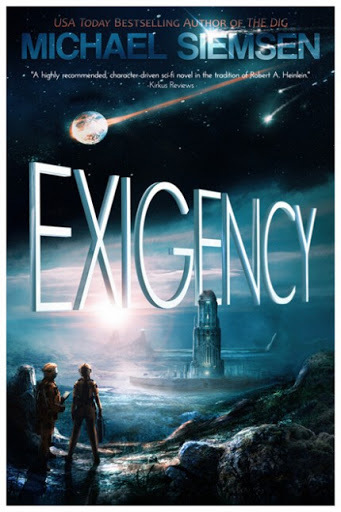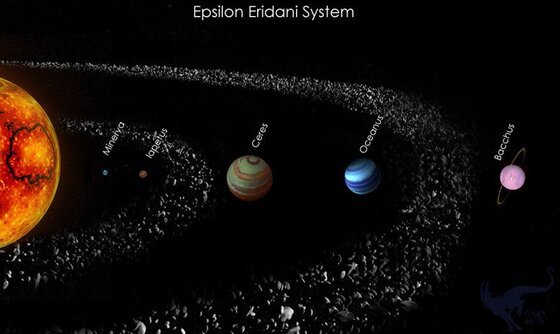
For six years they’ve been in orbit around Epsilon C, a rocky, Earth-like planet that hosts not one but two sentient species. The nine are on a mission of scientific exploration. They’ve devoted their lives to it. And they’ve learned a great deal about the local inhabitants. Even—with tiny probes eavesdropping on conversations on the ground—the languages they speak. But there’s no plan to descend to the surface . . . until a supply vessel collides with their station and forces them all into evacuation vehicles. The drama that ensues engages members of the mission in a variety of life-threatening episodes involving not just both alien species but the conflicts among them. And what the humans learn proves how little they had understood from their research.
A fractious bunch of scientists
In Exigency, author Michael Siemsen profiles each of the nine members of the mission to varying degrees. Two of them stand out: Minerva (“Minnie”) Sotiras and Aether Quintana, who have recently become a couple. Each in turn had been bunking with John Li, the mission commander, before they moved in together.
- Minnie is the team’s linguist. She has compiled a database of the languages spoken by the Threck, the more advanced of Epsy’s two sentient species. (Another of the scientists has studied the language of the violent predators known as the Hynka.)
- Aether is the deputy mission commander. Like John, she is a generalist who possesses the skills to maintain the peace among the quarrelsome bunch of scientists on the station.
Exigency by Michael Siemsen (2014) 440 pages ★★★★☆

Imaginative hard science fiction
Exigency is set far in Earth’s future, but not so far as to make the technology seem impossible. For example, each of the characters in the novel wears one “bio eye” and one “prosthetic fone eye.” The fone is a multi-purpose computer that doesn’t just broaden the spectrum of eyesight. It also enables virtual reality games and “direct communication” via text. And in each fone is LIVETRANS software that enables the wearer to understand and speak an alien language after it has been exposed to enough conversations. Which of course makes it possible for the characters in this novel to pull off meaningful First Contact with the two sentient species on the planet. It’s not too much of a stretch to imagine any of this technology coming online before the end of the twenty-first century.
Siemsen has solved a problem that would challenge any would-be long-distance mission to the stars: the need to stock enough food for nine people for many years on end. As he writes about Minnie, “Like the eight other individuals on the station and the dozens of others sent to distant planets on similar missions, she hadn’t consumed a solid for almost 27 years. Meds in the water shut down the majority of the digestive process, nutrients and calories supplied by supplements also infused the water. . . Even though the meds blocked the processes and signals that led to hunger sensations, it was difficult to comprehend the psychological impacts of food, the social importance of eating. The teams still gathered twice daily for this very reason.”
But I suspect this is all a lot less likely than the fone technology or the novel rocket propulsion system Siemsen depicts in Exigency. Our digestive system is designed to . . . well, digest food. And in its absence, what happens to the yards and yards of internal organs involved?
Where does the action take place?
Epsilon Eridani?
The nearest star with the world “Epsilon” in it is Epsilon Eridani, which is most likely the setting for Exigency. Epsilon Eridani is one of the stars closest to Sol, at 10.5 light-years’ distance. It’s a sun-like orange-red dwarf approximately one-third as bright as the sun. The orange light in the novel is consistent with this.
Three exoplanets discovered to date
Epsilon Eridani is a much younger star than our sun. Rings of dust and debris like our asteroid belt surround it, indicating an earlier stage in planetary formation. And in 2000 astronomers found an exoplanet in its orbit that follows an elliptical orbit requiring nearly seven years to complete one rotation.. The planet is probably a gas giant somewhere between 80% and 160% the mass of Jupiter, which would make its gravity crushing for human beings. In other words, it’s uninhabitable by anything resembling the life-forms on “Epsilon” in Michael Siemsen’s imagination. (On Epsilon C in the novel, the pull of gravity is just 1.5 times Earth’s.)
But in 2000 astronomers had identified only fifty extra-solar planets, and as of April 1, 2021, there were 4,704 confirmed exoplanets in 3,478 systems. Since 2000 later studies have identified at least two more planets in the system. Both appear to be gas giants in orbits far from their star. But it seems entirely possible that a later discovery closer in to the star lies in the habitable zone at which liquid water would be possible on the surface.
Two sentient species unrelated to each other?
Evolution is endlessly inventive and endlessly complex. On Earth, we humans characterize ourselves as the planet’s only sentient species. But there is abundant evidence that other species—raccoons, crows, pigs, and octopi as well as dolphins and elephants—possess high degrees of intelligence. It’s not too much of a stretch to imagine that, given another couple of hundred million years of evolution—or genetic engineering—one or another of these species could reach something approaching humans’ level of sentience. Which leads me to believe that a planet where two sentient species both live is not beyond the limits of credulity.
About the author

According to the bio on his official website, Michael Siemsen “grew up in Venice, California, the second son of a Vietnam veteran turned policeman. Initially focusing on performing arts, Michael attended the prestigious Alexander Hamilton Academy in Los Angeles. After serving in the U.S. Army as a tracked vehicle operator, he returned to civilian life and began writing short stories and screenplays, and directing short films and music videos. He is the author of six novels as well as audiobooks and short stories contributed to anthologies.
“Moving to Northern California in the late 90s, Michael met his future wife, Ana. The two now live near the San Joaquin River Delta with their equally adventurous children, as well as ‘the dogs,’ ‘that cat,’ and a fish or two.”
For more reading
Check out The five best First Contact novels.
For more good reading, check out:
- The ultimate guide to the all-time best science fiction novels;
- Great sci-fi novels reviewed: my top 10 (plus 100 runners-up);
- Seven new science fiction authors worth reading; and
- The top 10 dystopian novels reviewed here (plus dozens of others).
And you can always find my most popular reviews, and the most recent ones, plus a guide to this whole site, on the Home Page.


























